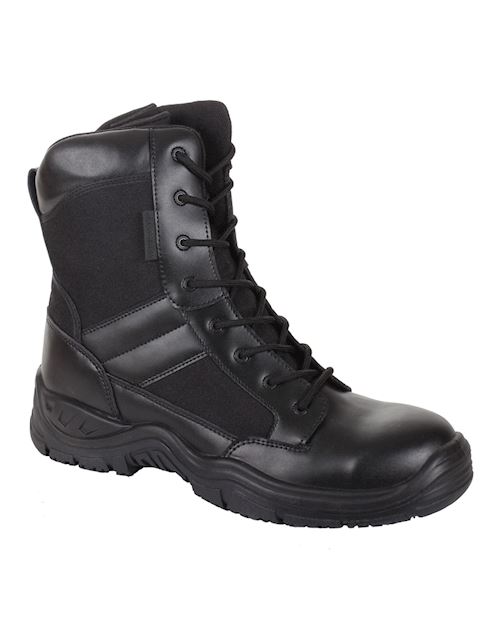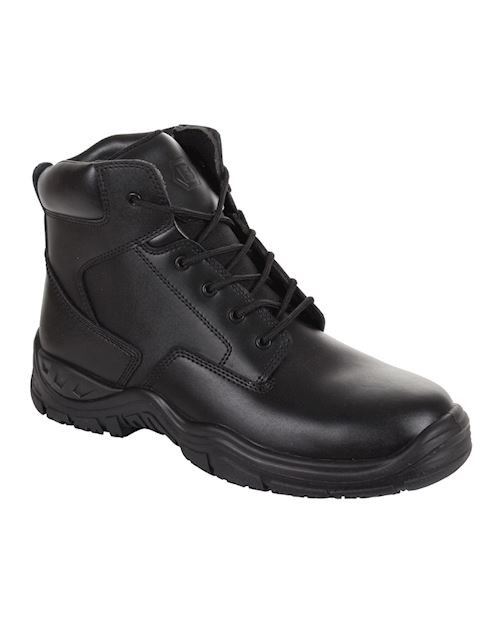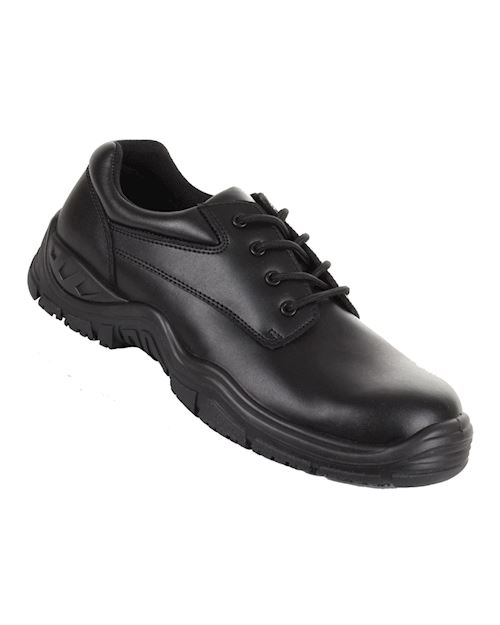Excellent new and innovative range of occupational footwear from Blackrock. GRIP 4 rated HexaGrip sole givies market-leading slip resistance. Far exeeds SRC slip rating. This combined with EaziStep insole made from lightweight PU/ mesh that gives all day comfort and relieves tension in areas vulnerable to stress such as the heel area and ball of the foot makes them suited for personnel who are not required to wear safety footwear as part of their uniform. Ideal for Police Authorites, Ambulance Trusts, Prison Services, Security Guards, Border Control Officers etc.
Injection moulded soles ensure excellent bond to the quality leather uppers and most models are fitted with a textile midsole to prevent penetration from sharp objects such as nails, glass etc.
GUIDE TO OCCUPATIONAL FOOTWEAR
Choosing the right specification of occupational non safety footwear for your work environment:
- You work indoor, no risk of water sprays, no need of protection for your toes, but you need good breathability? Then you need O1 occupational footwear
- You work indoor, no risk of water sprays, no need of protection for your toes, but you need protection against perforation and a good breathability? Then you need O1P occupational footwear with a protective midsole
- You work outdoor, no need of protection for your toes but you need protection against water sprays? Then you need O2 occupational footwear
- You work outdoor, no need of protection for your toes, but you need protection against perforation and against water sprays? Then you need O3 occupational footwear that is water resistant and has a protective midsole
- What other features should I consider for my O1, O1P, O2, O3 occupational footwear?
As you can see, the biggest difference between O1, O1P, O2, O3 occupational footwear is the resistance to water sprays and the puncture resistant midsole. The O1P and O3 are basically O1 and O2 occupational footwear, with an additional puncture resistant midsole.
When choosing your occupational footwear, first you need to know some description coming from the norms. O1, O1P, O2, O3 occupational footwear follow the UNI EN ISO 20347 standard:
EN ISO 20347 = Personal Protective Equipment – Specifications for Occupational footwear. This footwear is not equipped with toecap for toes protection.
The properties of O1, O1P, O2, O3 occupational footwear are:
All of them are class I footwear.
O1 occupational footwear has the basic properties of OB (open heel) footwear plus:
- Closed seat region
- Antistatic properties (including the “A” marking)
- Energy absorption of seat region (including the “E” marking)
- Resistance to fuel oil
O1P occupational footwear is an O1 footwear plus:
- Penetration resistance (including the “P” marking)
O2 occupational footwear has the basic properties of OB footwear plus:
- Closed seat region
- Antistatic properties (including the “A” marking)
- Energy absorption of seat region (including the “E” marking)
- Resistance to fuel oil
- Water penetration and absorption
O3 occupational footwear is an O2 footwear plus:
- Penetration resistance (including the “P” marking)
- Cleated outsole
O1, O1P, O2, O3 occupational footwear can also have some other markings if they have additional features, basically needed in special work applications/environments:
- AN = Ankle protection (≤ 10 kN). The mean value of the test result shall not exceed 10KN and no single value shall exceed 15KN
- CI = Cold insulation of the outsole (test at -17ºC). When tested, the temperature decrease on the upper surface of the insole shall not be more than 10ºC
- ESD = ElectroStatic Discharge (between 100 KΩ and 35 MΩ). ESD shoes (electrostatic discharge) do not primarily protect the person but rather protect the ElectroStatic Discharge Sensitive devices (ESDS) in sensitive working areas (called EPA = Electrostatic Protected Areas).
- HI = Heat insulation of the outsole (test at 150ºC). When tested, the temperature increase on the upper surface of the insole after 30 min. shall not be greater than 22ºC. After the test the outsole must not present damages that could affect the regular usage of the footwear and its performances. The insulation must not be removable from the shoe.
- HRO = Resistance to hot contact of the outsole (test at 300ºC). When tested rubber and polymeric outsoles should not melt or crack when bent
- WR = Water resistance (for O2 and O3). The total wetted area inside the footwear shall be ≤ 3cm² when tested.












Join our newsletter list and be first to get our offers & deals